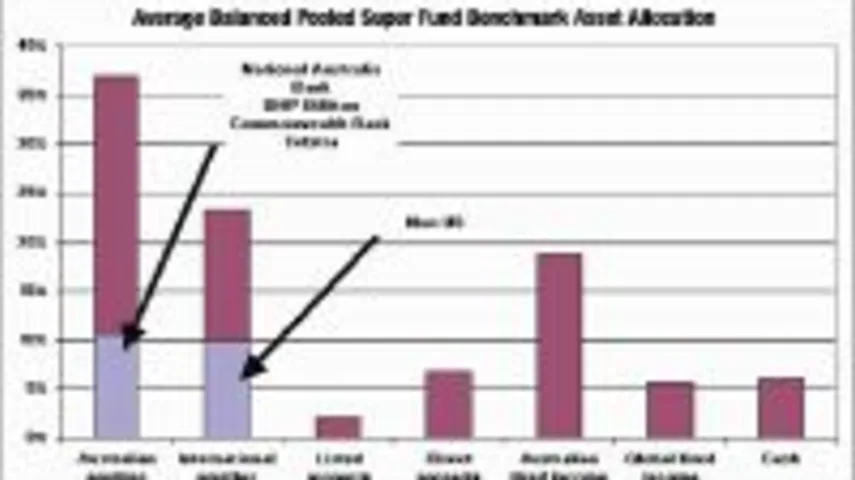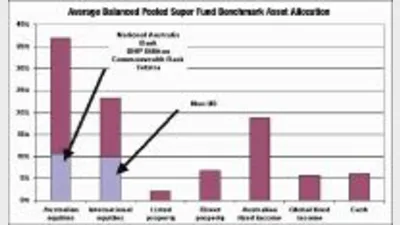Investors stay home a little too often



Home bias in the Australian investment market is neither unique nor unusual despite the relatively minor size of the Australian market on the global stage.
That there is a home bias, that is the tendency of investors to weight investments close to home differentially in the portfolio regardless of the risk/return characteristics or potential impact, is unmistakable.
For example, the average Australian balanced portfolio has a significant bias towards domestic equity. Of the 64 per cent that is held in equity, 39 per cent is in Australia and 25 per cent is invested in global equities. And this is despite that fact that Australia represents only two per cent of the global equity market, (see table).
As a result of this bias, there is as much invested in the top four Australian companies as is invested cumulatively in all the companies in every other country in the MSCI World Developed Market Index except the US.
That means that the top four Australian companies are as important in determining the future returns of the portfolio as are the 10,129 other companies in the developed market index excluding the US.
The interesting thing about this bias towards Australian equities is that if the same analysis was done for, say, the UK, the US, Japan or Germany you would find a similar home bias.
It may not be as extreme because of the unique concentration of large companies in the Australian market, but it would still be evident that assets close to home are preferred over foreign assets. Most market investors have a tendency to preferentially weight domestic assets over foreign assets.
Now this portfolio bias may very well be the right allocation in the short-term. It certainly has been over the two years to June 30, 2002.
In that period, global equities fell by an average of 15 per cent per annum versus a significantly better two per cent per annum return to Australian equities. For the two-year period to September 30, 2002, global equities provided an average return of negative 24 per cent per annum versus Australian equity’s average return of negative two per cent per annum.
But this has been a pretty extreme period. And it is important to separate strategic from tactical decisions. The question that an investor has to ask is ‘Will Australia always be the best performing market?’
The only investor that doesn’t need to diversify is the investor who can predict the future perfectly. For the rest of us, diversification ensures that a portfolio is protected against the adverse impact of any single investment alternative.
Deviations from a fully diversified portfolio can only be justified on the basis of additional return or lower risk than the market is expecting or currently pricing.
An example of this is franking credits. There is a distinct advantage for a domestic tax-paying investor to hold Australian tax-paying companies.
Analysis suggests that the impact of franking credits is to give the domestic investor a 1.1 per cent return incentive to hold more Australian equities in their portfolio. From a portfolio construction angle, the optimal equity portfolio would be 16 per cent Australian equities and 48 per cent global equities — still a long way from the current 39/25 split.
Another justification for the Australian equity home bias is the perception of greater excess return opportunities for active managers.
For the five years to June 30, 2002, the median active Australian equity manager has returned an average excess return of 1.5 per cent per annum or after taking out fees, 0.8 per cent per annum. The median (Australian domiciled) active global equity manager, however, has only returned an average of 1.1 per cent per annum, which when adjusted for (higher) fees, reduces to 0.2 per cent per annum.
Ignoring the fact that the median tracking error over this period for an active Australian equity portfolio (2.5 per cent) is less than half that of the median active global equity portfolio (5.5 per cent ), this implies a naive active return advantage of 0.6 per cent per annum.
Incorporating this active return advantage into the same optimisation approach employed above, the optimal equity portfolio (including the franking credit benefit) moves from 16 per cent Australian equities and 48 per cent global equities to 26 per cent Australian equities and 38 per cent global equities. While certainly closer to the 39/25 balanced fund allocation, the optimised portfolio allocation is still considerably different.
While franking credits and active return advantage have been suggested as ‘reconciling items’, an Australian equity home bias of about 13 per cent is still present.
Foreign currency risk is sometimes viewed as a deterrent to global investment and contributor to the home bias phenomenon. It is a risk however that may be easily and cheaply managed through currency hedging.
Another deterrent to global investing is compliance risk. This can also be easily and inexpensively managed, and in most cases is assumed by the underlying manager and custodian.
With the currency risk and compliance risk arguments not holding much water, this leaves other issues to explain the home bias in Australian balanced portfolios.
An argument exists in favour of investing more in the Australian market in order to enhance the stability and security of the local economy.
When one considers the business interests of News Corporation, BHP Billiton, AMP and Telstra (and the fact that the top 10 Australian companies represent close to 50 per cent of the local index) it becomes evident that investing in the domestic market also promotes the stability and security of the economies of the US, UK, Europe and Asia.
From an employment and infrastructure perspective, this argument is plausible, but when examined in more detail, investing in Australian equities to promote the local economy is also unacceptable in validating the home bias.
It may also be that the home bias is purely behavioural. There have been a number of academic studies that suggest there is a tendency for investors to bias their investments towards assets that are closer to home.
One of these studies found that there is a tendency for US equity managers to bias their US equity portfolios towards companies that are closer to the hometown of the portfolio manager.
There may be good reasons to do this at the stock level by arguing greater knowledge of local conditions or greater insight into the operating effectiveness of the company. However, it is less likely that this skill bias exists at the country level, meaning that this cannot be used as a reason to bias investment towards an entire country.
While franking credits and perceived active return potential are useful reconciling items, the ‘optimal world equity portfolio’ still has a 13 per cent lower allocation to domestic equities than the average Australian balanced fund.
The key to this difference is far removed from risk/return expectations, rather it lies in the foundations of human nature and our comfort with what is familiar. I believe that the Australian home bias will persist over time, but with a declining behavioural component as a result of greater global comfort, it will approach a more ‘optimal’ level.
Lochiel Crafter is the chief investment officer with SSgA Australia.
Recommended for you
In this episode of Relative Return Insider, host Keith Ford and AMP chief economist Shane Oliver unpack the RBA’s decision to keep the cash rate on hold in the face of rising inflation and whether the governor’s hawkish tone is a sign of things to come.
In this episode of Relative Return Insider, host Keith Ford and AMP chief economist Shane Oliver discuss the September quarter GDP figures, which show Australia’s economy regaining momentum.
In this new episode of The Manager Mix, host Laura Dew speaks to Haley Devine, head of wealth management at MaxCap Group, to delve into private credit and commercial real estate.
In this new episode of The Manager Mix, host Laura Dew speaks to Benjamin Leung, head of systematic investments at Macquarie Asset Management, to understand the use of systematic investments.







